This article needs additional citations for verification .(July 2012) |

Cold Northcott is a hamlet in Cornwall, England, UK.[ citation needed ] It is on the A395 road two miles southeast of Hallworthy. [1] It is in the civil parish of St Clether.
This article needs additional citations for verification .(July 2012) |

Cold Northcott is a hamlet in Cornwall, England, UK.[ citation needed ] It is on the A395 road two miles southeast of Hallworthy. [1] It is in the civil parish of St Clether.
Cold Northcott wind farm is a wind farm situated near the hamlet either side of the A395. It consists of 22 twin-bladed turbines (similar to Great Eppleton) with a nameplate electrical capacity of 6.6 megawatts and estimated annual output of 16 GWh. [2] The turbines began operation in April 1993 and are manufactured by Cumbrian Wind Farms. Cold Northcott wind farm is operated by a three-man crew of engineers who perform routine maintenance on the wind turbines. The turbines are manufactured by WEG. In early 2016 the 22, twin-bladed, wind turbines were out of use due to health and safety regulations. After being out of use for nearly six months, from June 2016, 20 turbines returned to use. Two turbines are still out of use due to one being struck by lightning. The other turbine, that is out of use, had a faulty gearbox. This then caused the blades to blow off during a storm, which resulted in the whole wind farm closing for nearly six months due to health and safety regulations. During the six months, the crew of engineers carried out maintenance on the operational turbines.

A windpump is a wind-driven device which is used for pumping water.

Wind power is the use of wind energy to generate useful work. Historically, wind power was used by sails, windmills and windpumps, but today it is mostly used to generate electricity. This article deals only with wind power for electricity generation. Today, wind power is generated almost completely with wind turbines, generally grouped into wind farms and connected to the electrical grid.

A wind farm or wind park, also called a wind power station or wind power plant, is a group of wind turbines in the same location used to produce electricity. Wind farms vary in size from a small number of turbines to several hundred wind turbines covering an extensive area. Wind farms can be either onshore or offshore.
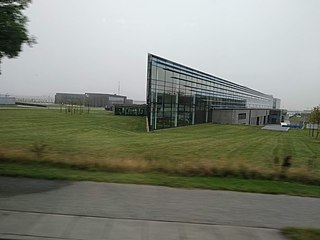
Vestas Wind Systems A/S is a Danish manufacturer, seller, installer, and servicer of wind turbines that was founded in 1945. The company operates manufacturing plants in Denmark, Germany, the Netherlands, Taiwan, India, Italy, Romania, the United Kingdom, Spain, Sweden, Norway, Australia, China, Brazil, Poland and the United States, and employs 29,000 people globally.
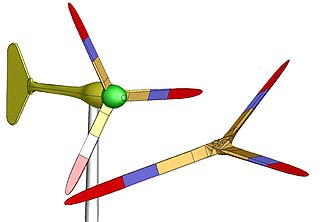
Small wind turbines, also known as micro wind turbines or urban wind turbines, are wind turbines that generate electricity for small-scale use. These turbines are typically smaller than those found in wind farms. Small wind turbines often have passive yaw systems as opposed to active ones. They use a direct drive generator and use a tail fin to point into the wind, whereas larger turbines have geared powertrains that are actively pointed into the wind.
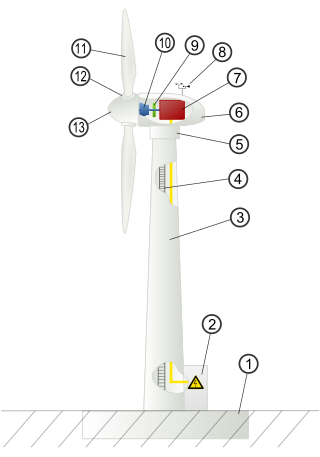
Wind turbine design is the process of defining the form and configuration of a wind turbine to extract energy from the wind. An installation consists of the systems needed to capture the wind's energy, point the turbine into the wind, convert mechanical rotation into electrical power, and other systems to start, stop, and control the turbine.
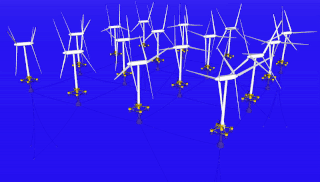
Unconventional wind turbines are those that differ significantly from the most common types in use.
Siemens Gamesa Renewable Energy, S.A. was formed in 2017 in a merger of Siemens' Wind Power division with Gamesa Corporación Tecnológica, S.A.; it is a Spanish-German wind engineering company based in Zamudio, Biscay, Spain. The company has two other main sites in Spain: one in Madrid and the other in Sarriguren. Other than its headquarters, its onshore business is primarily based in Spain, while the offshore business is based in Germany and Denmark. It is the world's second largest wind turbine manufacturer behind Vestas.

A turbine engine failure occurs when a turbine engine unexpectedly stops producing power due to a malfunction other than fuel exhaustion. It often applies for aircraft, but other turbine engines can fail, like ground-based turbines used in power plants or combined diesel and gas vessels and vehicles.
Wind power in Ohio has a long history. As of 2016, Ohio had 545 megawatts (MW) of utility-scale wind power installations, responsible for generating 1.1% of the state's electricity. Over 1000 MW more were under construction or pending approval. Some installations have become tourist attractions. There has been a sudden increase in generating capacity, as the total wind power capacity in the state was just 9.7 MW in 2010. By 2019, there were 738 MW of capacity, which generated 1.71% of Ohio's electricity.

Making up over 62% of the state's generated electricity in 2022, wind power is the largest source of electricity generation in Iowa. In 2020, over 34 billion kWh of electrical energy was generated by wind power. As of 2022, Iowa has over 12,200 megawatts (MW) of installed capacity with over 6,000 wind turbines, ranking second and third in the nation below Texas respectively.

A floating wind turbine is an offshore wind turbine mounted on a floating structure that allows the turbine to generate electricity in water depths where fixed-foundation turbines are not feasible. Floating wind farms have the potential to significantly increase the sea area available for offshore wind farms, especially in countries with limited shallow waters, such as Spain, Portugal, Japan, France and the United States' West Coast. Locating wind farms further offshore can also reduce visual pollution, provide better accommodation for fishing and shipping lanes, and reach stronger and more consistent winds.
The wind power industry is involved with the design, manufacture, construction, and maintenance of wind turbines. The modern wind power industry began in 1979 with the serial production of wind turbines by Danish manufacturers. The industry is undergoing a period of rapid globalization and consolidation.

The environmental impact of electricity generation from wind power is minor when compared to that of fossil fuel power. Wind turbines have some of the lowest global warming potential per unit of electricity generated: far less greenhouse gas is emitted than for the average unit of electricity, so wind power helps limit climate change. Wind power consumes no fuel, and emits no air pollution, unlike fossil fuel power sources. The energy consumed to manufacture and transport the materials used to build a wind power plant is equal to the new energy produced by the plant within a few months.
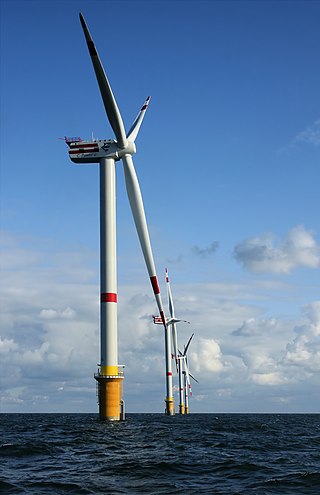
A wind turbine is a device that converts the kinetic energy of wind into electrical energy. As of 2020, hundreds of thousands of large turbines, in installations known as wind farms, were generating over 650 gigawatts of power, with 60 GW added each year. Wind turbines are an increasingly important source of intermittent renewable energy, and are used in many countries to lower energy costs and reduce reliance on fossil fuels. One study claimed that, as of 2009, wind had the "lowest relative greenhouse gas emissions, the least water consumption demands and the most favorable social impacts" compared to photovoltaic, hydro, geothermal, coal and gas energy sources.

Carland Cross is a location in Cornwall, England, United Kingdom, about six miles north of Truro at OS grid reference OS grid ref SW846539. At Carland Cross there are a hamlet, a road junction and a large wind farm. The road junction is in the civil parish of St Erme, very close to the boundary with St Newlyn East.
Modern United States wind energy policy coincided with the beginning of modern wind industry of the United States, which began in the early 1980s with the arrival of utility-scale wind turbines in California at the Altamont Pass wind farm. Since then, the industry has had to endure the financial uncertainties caused by a highly fluctuating tax incentive program. Because these early wind projects were fueled by investment tax credits based on installation rather than performance, they were plagued with issues of low productivity and equipment reliability. Those investment tax credits expired in 1986, which forced investors to focus on improving the reliability and efficiency of their turbines. The 1990s saw rise to a new type of tax credit, the production tax credit, which propelled technological improvements to the wind turbine even further by encouraging investors to focus on electricity output rather than installation.

On 13 July 2011, Noar Linhas Aéreas Flight 4896, a Let L-410 Turbolet passenger aircraft on a domestic service from Recife to Mossoró, Brazil, crashed shortly after take-off in the Boa Viagem neighbourhood of Recife, after suffering an engine failure. All 16 people on board were killed.

Block Island Wind Farm was the first commercial offshore wind farm in the United States, located 3.8 mi (6.1 km) from Block Island, Rhode Island in the Atlantic Ocean. The five-turbine, 30 MW project was developed by Deepwater Wind, now known as Ørsted US Offshore Wind.
Warradarge Wind Farm is located 15 kilometres (9.3 mi) northeast of Warradarge, and 30 kilometres (19 mi) southeast of Eneabba in the Mid West region of Western Australia. Construction commenced in 2019 and the first of its planned 51 turbines was completed on 21 January 2020. The wind farm has been operational since August 2020.
50°39′01″N4°32′26″W / 50.65014°N 4.54069°W